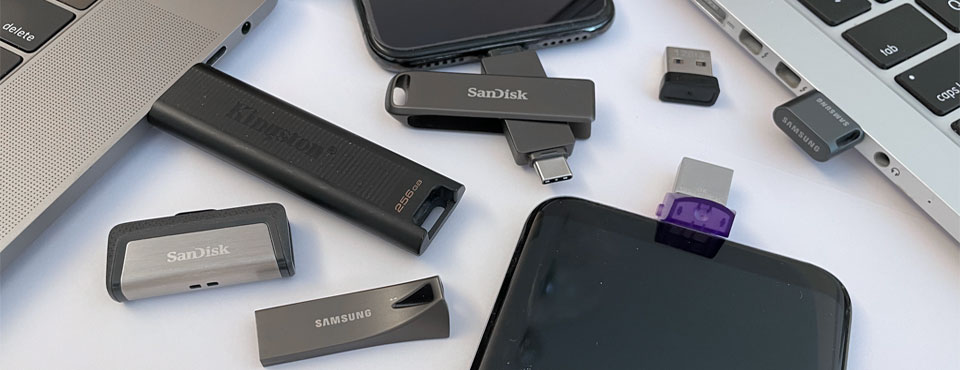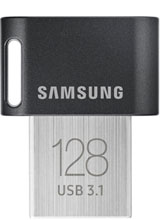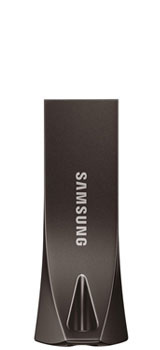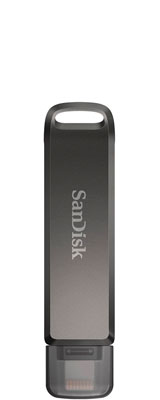
November 2022 Ian Chiu
Most generic thumb drives are a dime a dozen but there are other types of flash drives available to suit different kinds of use. They include high performance, dual interfaced, low profile, durable, high security, and novelty. After reviewing no less than twenty flash drives, we’ve picked five that are the best there are in their respective categories.
Contents
Overview of the Best Flash Drives
 Kingston DataTraveler Max $34.91 for 256GB |  Transcend ESD310 $28.02 for 256GB |  Samsung FIT Plus $22.99 for 256GB |  Samsung BAR Plus $21.99 for 256GB |  Sandisk iXpand Luxe $29.99 for 256GB |
|
|---|---|---|---|---|---|
| Drive Type: | High-performance thumb drive | Dual-head flash drive | Mini flash drive | Durable flash drive | iPhone flash drive |
| Interface: | USB 3.2 Gen 2 10Gbps (Type-C) | USB 3.2 Gen 2 10Gbps (Type-A & Type-C) | USB 3.2 Gen 1 5Gbps (Type-A) | USB 3.2 Gen 1 5Gbps (Type-A) | Apple Lightning, USB 3.2 Gen 1 5Gbps (Type-C) |
| Storage Options: | 256GB - 1TB | 256GB - 2TB | 32 - 512GB | 32 - 512GB | 64 - 256GB |
| USAP? | Yes | Yes | No | No | No |
| Movie Read: (10GB MP4) | 725.08MB/s | 787.78MB/s | 336.49MB/s | 284.44MB/s | 87.81MB/s |
| Movie Write: (5GB MP4) | 552.52MB/s | 554.65MB/s | 114.65MB/s | 41.75MB/s | 33.84MB/s |
| Photo Read: (5GB JPEG) | 527.08MB/s | 692.7MB/s | 294.54MB/s | 223.67MB/s | 77.07MB/s |
| Photo Write: (10GB JPEG) | 364.49MB/s | 341.97MB/s | 92.48MB/s | 38.41MB/s | 27.77MB/s |
| Software: | None | None | None | None | Sandisk iXpand iOS app |
| Dimensions: | 82.2 x 22 x 9mm | 71.3 x 20 x 7.8mm | 23.6 x 18.8 x 7.8mm | 15.6 x 40 x 11.7mm | 50 x 15 x 8mm |
| USB Plug Protection? | Retractable connector | Two removable caps on opposite ends | None | Cap | Swivel design & extra cap |
| Build Material: | Plastic | Metal body, plastic caps | Plastic grip, aluminum body | Metal unibody | Plastic |
| Color(s): | Black | Black, silver & pink | Gray | Frozen black, silver | Grey |
| Release Date: | Aug 2021 | April 2023 | June 2018 | April 2018 | March 2021 |
| Warranty: | 5 years | 5 years | 5 years | 5 years | 2 years |
Pricing is last updated by Amazon on 2025-04-24 at 20:23. When you buy through Amazon affiliate links on our site, we may earn an affiliate commission.
Fastest Large-capacity Flash Drive
Our choice is Kingston DataTraveler Max. It is built for speed with a raw capacity of 1TB. Powered by Silicon Motion’s SM2320 UFD controller, it is the industry’s first SSD packaged in a thumb drive whose performance not only outclasses all the thumb drives we’ve tested but also rivals that of some USB 3.2 SSDs. The USB 3.2 Gen 2×1 (10Gbps) flash drive also comes in both USB-C and USB-A variants but you can always grab an adapter to expand compatibility. Our only caveat is that the drive encased in a plastic body is not as durable as we would like it to be.
- Advanced USB 3.2 Gen 2 Type-C USB
- Unique ridged casing with keyring loop
- Up to 1,000MB/s read speeds
Best Dual Flash Drive
Transcend ESD310 is our favorite when it comes to dual flash drives. Like other drives in the same category, the ESD310 is meant to serve as a bridge between contemporary USB-C and legacy USB-A ports. As such, it can be used to exchange gigabytes of data between different platforms effortlessly without waiting for files to sync with cloud. The dual-head flash drive – like the Kingston DataTraveler Max – is also like a SSD on a flash drive so it’s built for speed in mind. Transcend ESD310 comes with two removable caps for plug protection as well as preventing the drive’s sharp edges from puncturing jean pockets.
- Blazing Fast 1050MB/s Speed : Experience ultra-fast 10Gbps transfer speeds with cutting-edge...
- Universal Compatibility : Compatible with Steam Deck, ROG Ally, MSI Claw, Windows, Mac, iPhone,...
- 2-in-1 Dual USB-C & USB-A Design : Equipped with both USB-C and USB-A 3.2 ports, this...
Best Mini Flash Drive
The Samsung Fit Plus is a solid choice and earns our recommendation. While it is generally outperformed by the second-generation SanDisk Ultra Fit in most areas, the Samsung Fit Plus excels in small file write speeds — delivering performance over three times faster than the SanDisk. It’s important to set realistic expectations, as low-profile drives are not designed to match SSD-grade speeds. However, they are more than capable of freeing up space on a laptop’s internal SSD for other critical applications.
- COMPACT FLASH DRIVE: Exceptionally compact Samsung FIT Plus USB flash drive for instant storage...
- QUICK AND CONVENIENT READ SPEEDS: Redefine everyday file transfers with read speeds up to...
- SEAMLESS FITTING DESIGN: The unnoticeable, seamless fit is designed with a key ring to prevent...
Most Durable Everyday Flash Drive
Samsung BAR Plus is by far the most durable everyday flash drive we’ve tested. It comes with a metal unibody design adds to its toughness. Compared to other drives that are mostly all-plastic affairs, Samsung BAR Plus’s solid construction is quite reassuring. We didn’t call the drive the most rugged because people would have higher expectations for its survivability. In fact, Samsung BAR Plus hasn’t received an IP rating yet it is water-resistant, dust-proof, shock-proof, and magnet-proof.
There are extremely rugged drives that truly live up to their names. In most cases, they are made with a proprietary material that is designed to survive impacts, immersion, intense pressure, and even fire. If you have special requirements, there are plenty of storage options available. They usually come at a price premium as they are usually accompanied by a long warranty period and data recovery service.
- Redefine everyday file transfers with speeds up to 400MB/s
- Reliable and secure storage for your photos, videos, music, and files
- Rugged metal casing for durability with key ring to prevent loss.Operating Temperature:0~60℃
Best Flash Drive for iPhone
Sandisk iXpand Luxe is our choice for the best iPhone flash drive. The latest generation of iXpand improves upon its predecessor with its swivel design and metal construction. Such a drive serves well whether you need to back up newly-filmed 4k video assets or playback media files encoded in a wide variety of formats. Sandisk’s iOS app is also fairly polished and stable after years of updates.
Sandisk iXpand Luxe however likely is the last of a dying breed. There will not be much demand for storage devices with dual Lightning and USB interface when future iPhones are began to adopt USB-C in 2023. By that time, USB-C flash drives will take over as the de facto external storage solution for future iPhones. That said, there are still millions of iPhone owners out there who will hang on to their devices so they will need something like Sandisk iXpand Luxe for on-the-go backup.
- The all-metal casing 2-in-1 flash drive with Lightning and USB Type-C connectors.
- Seamlessly move content between your iPhone, iPad Pro and USB Type-C devices, including Android...
- (1) For iPhone, iPad Pro and iPod compatibility, see SanDisk Support ixpand compatibility web...
Nexcopy manufactures a variety of PC-based and standalone USB duplicator solutions.
PC based systems support advanced USB functions such as write protection, CD-ROM partition and multi-partition creation, while standalone systems are ultra-fast, high speed USB copiers duplicating gigabytes of data quickly and accurately.






